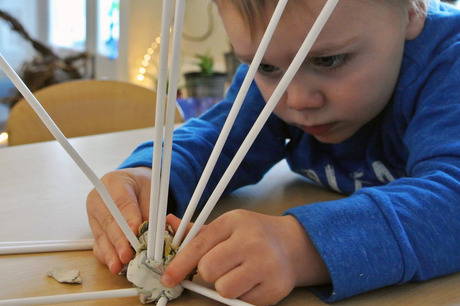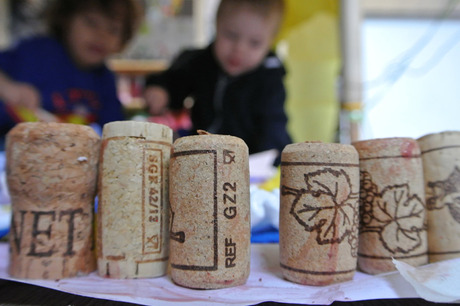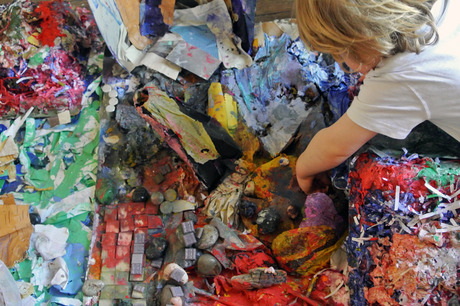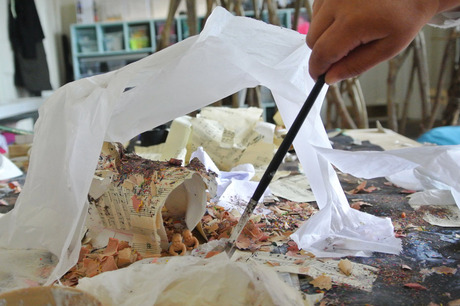
The latest book from Reflections Nursery & Forest School in Worthing, West Sussex, documents the thoughts and ideas of pre-school children during a year-long focus on ‘storying’, or the use of narrative arising from children’s everyday play and independent investigations.
The book, The Revolutionary Baby, emerged from the ideas of two-year-old Etta, who created the character of a ‘big strong baby’ while exploring themes relating to babies in peril, dangerous monsters and things that could grow bigger.
Reflections’ pedagogical consultant Deb Wilenski explains, ‘Through the adventures of a tiny baby the children investigated good and bad, power and vulnerability, danger and defiance. They also made radical new combinations of these ideas. If the tiny baby is a revolutionary who crosses boundaries and travels between worlds, the children who told his stories are revolutionaries too.’

Jack makes a playground
INSPIRATION
Reflections draws its inspiration from the pre-schools of Reggio Emilia in northern Italy. It has an atelier (art studio) and employs two full-time atelieristas (artists), and the children regularly engage in long-term project work, usually inspired and led by their own ideas and interests.
Each year alongside these projects Reflections’ educators focus on a particular language of expression. ‘In 2013 this was sculpture, this year it is sound, and last year our focus was storying,’ explains Ms Wilenski.
‘People often think stories are things adults tell to children. We wanted to begin from the opposite direction, by listening for children’s own stories and elements of stories in their everyday lives and relationships.’
The actual story of The Revolutionary Baby evolved from another child’s imaginings and stories about a fire monster. Children throughout the nursery were painting and drawing fiery pictures and creating play scenarios involving monsters, volcanoes and dragons.
This led to them building two worlds on and under a table. Etta introduced some babies that she had made out of blobs of clay and created a ‘baby place’ underneath the table and a ‘monster place’ on top. Other children joined her play and helped her to further develop the two places.
What emerged were two contrasting worlds, a safe comfortable space for babies and a dark dangerous space for monsters. Etta was insistent that the two places remained separate. She built a wall and disallowed other children from placing babies in the monster world and vice versa. Luca and Theo build a wall to protect the baby
Luca and Theo build a wall to protect the baby
STAGES OF DEVELOPMENT
Ms Wilenski says Reflections’ atelieristas constantly observe and document daily, recording observations and keeping notes, then summarising these twice a week to display on the atelier door for visitors and parents. The atelieristas also meet once a week with other educators in their section to share their recordings and observations and discuss how to develop the focus.
During the initial period of storying about monsters and babies, educators observed the children with as little intervention and direct conversation as possible. ‘We began with a period of intense listening and recording using cameras, video recorders, notebooks, collecting the children’s created work, scribing children’s conversations and descriptions, revisiting recordings in our educator meetings, and recording our own thoughts, noticing how narratives took place in movement as well as words,’ explains Ms Wilenski.
The educators then became facilitators, supporting the children’s ideas by making ‘offers’ in the form of materials, images, objects and conversations that revisited ideas to extend the children’s thinking.
‘Often our interventions as practitioners are as minimal as possible and introduced slowly with lots of time between,’ says Ms Wilenski. ‘Minimal doesn’t necessarily mean small; when we use projections, for example, these are dramatic and large but still minimal in that they have a specific purpose linked to the children’s current ideas and investigations.
‘In the case of The Revolutionary Baby, materials and spaces were offered around the ideas of change and transformation,’ she explains. ‘Children were particularly interested in making things get bigger and bigger so materials were offered that could grow incrementally; papier-mâché, dough, liquids with bicarbonate of soda.
‘At the same time the children became interested in monstrous change so our atelierista Laura Magnavacchi offered visual ways of exploring this, showing them source books on mythical creatures, looking closely at eyes and skin of strange creatures and projecting these onto a blank white wall so the children could transform themselves too by allowing the images to meet their own bodies.’
Ms Wilenski then introduced a tiny inch-long toy baby to the scene. ‘When we thought about introducing the model of the baby we weren’t sure about it,’ she says. ‘The children were already making their own more abstract babies in clay and it felt like it could be too defined and prescriptive to bring in this man-made one. It was the way the children brought him into the relationship with their clay work and their atelier that convinced us that the provocation had worked well and should be continued with.’
Etta viewed the toy baby differently from the others, describing it as a ‘big strong baby’ and allowing it to break the rules and travel between the baby and monster worlds. The tiny baby triggered exploration of a number of themes including good and bad, power and vulnerability, and danger and defiance. Kobias protects the baby inside the house
Kobias protects the baby inside the house
STORY-BUILDING
Educators made the very deliberate decision not to introduce any other stories to the children too early on. Ms Wilenski says they felt this was very important because their aim was to listen to the children’s own stories and allow them to evolve without outside influence.
‘As we had decided very deliberately to begin by listening to the children’s own stories, we also made a conscious decision not to introduce any of the many stories in folklore and fairy-tale traditions around the world about baby heroes at this point.
‘We had recorded two opposite kinds of stories among the children; big dangerous tales of monsters and powerful forces, and smaller domestic stories of home life and families. In our weekly project planning meeting we realised that the relationship between these two kinds of stories was a fascinating one, and that we would see how the model of the baby and its introduction as a character in the atelier would affect the story-making of the children.
‘Vivian Gussin Paley often makes the point that of course children will bring into their own story-making all the other stories they have seen and heard from books, film, parents, grandparents and friends. We talk a bit about this on page two of the book, where we have the map of the project.
‘I think what’s important is how the children recombine familiar worlds with their own and that we make subtle observations of these; for instance, what aspects are they connecting.’
Miss Wilenski says it was eight months before they introduced the children to other stories and, when they did so, there was a reason for choosing each one, linked to an aspect of the children’s explorations.
An explanation of these thought processes can be found within The Revolutionary Baby in the chapter ‘Tiny Heroes’.
IN THE MAKING

A house for the two babies
To produce the book, the Reflections team first created an overview of the project by revisiting their observations and recordings, pinpointing the beginning, highlighting developments and thinking about what made them so significant.
The team then discussed how to structure the book, picking out big ideas and themes and considering them in relation to wider cultural contexts; for example, the tradition of storytelling about bravery and danger. Atelierista Laura Magnavacchi created a first draft, which pedagogical consultant Deb Wilenski then used to build the conceptual framework of the book.
She explains, ‘The project was still going on and as we began to construct the book it became much clearer that the role of the baby was a “revolutionary” one; that he had really mixed up and made more subtle the strong opposite ideas the children had been exploring.
‘We learnt to look out for these gradations in the children’s meaning-making in the latter part of the project, as well as the ways in which they were revisiting key concepts like safety and danger, power and vulnerability, the monstrous and the human.’
MORE INFORMATION
The Revolutionary Baby: An adventure in two year olds’ story-making by Laura Magnavacchi and Deborah Wilenski, £11, from Onreflection Publishing. Email: eonone@reflectionsnurseries.co.uk or go to www.onreflectionpublishing.co.uk
For documentation fromThe Revolutionary Babyand other projects, see www.reflectionsnurseries.co.uk/documentation/4591057350
For other Reflections projects – ‘We’ve explored… fire’, ‘Let’s explore…crocodiles’, ‘Let’s explore…light’ – visit: www.nurseryworld.co.uk
The Hundred Languages of Children: The Reggio Emilia Experience in Transformation by Carolyn Edwards, Lella Gandini and George Foreman, Greenwood Press
The Project Approach: Creativity in the early years by Marianne Sargent, Practical Pre-School Books
Bringing the Reggio Approach to your Early Years Practice by Linda Thornton and Pat Brunton, Routledge
Marianne Sargent is a writer specialising in early years education and a former foundation stage teacher and primary and early years lecturer.









